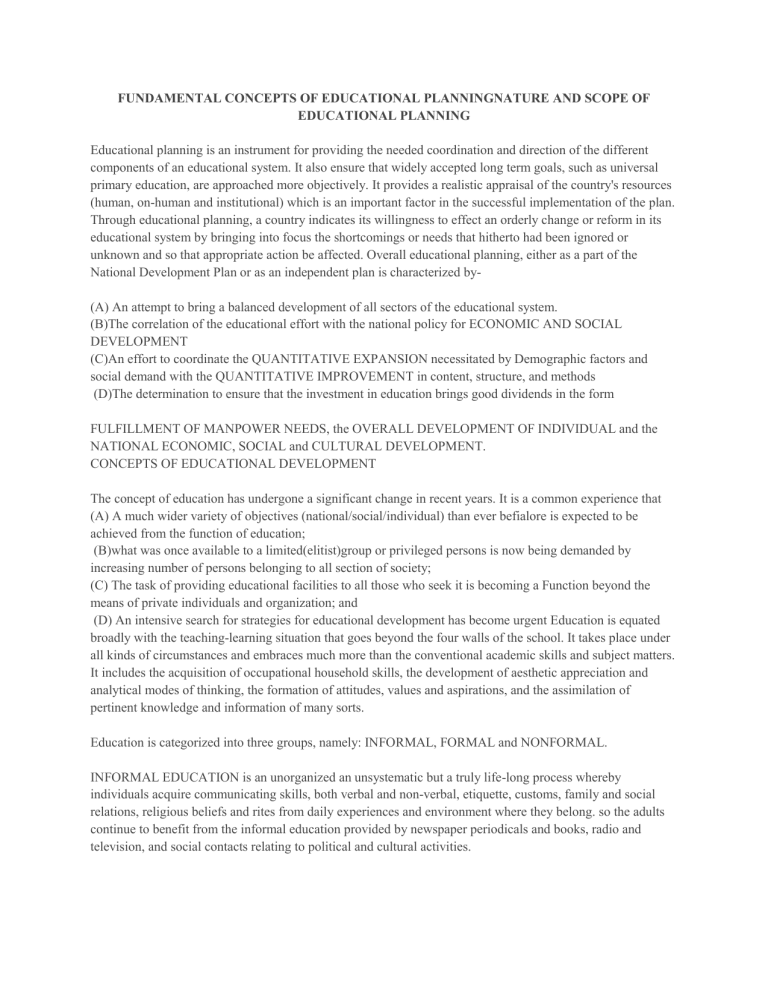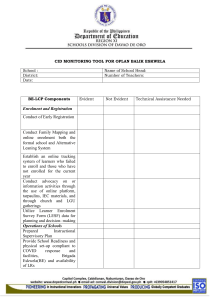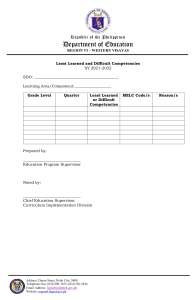
FUNDAMENTAL CONCEPTS OF EDUCATIONAL PLANNINGNATURE AND SCOPE OF EDUCATIONAL PLANNING Educational planning is an instrument for providing the needed coordination and direction of the different components of an educational system. It also ensure that widely accepted long term goals, such as universal primary education, are approached more objectively. It provides a realistic appraisal of the country's resources (human, on-human and institutional) which is an important factor in the successful implementation of the plan. Through educational planning, a country indicates its willingness to effect an orderly change or reform in its educational system by bringing into focus the shortcomings or needs that hitherto had been ignored or unknown and so that appropriate action be affected. Overall educational planning, either as a part of the National Development Plan or as an independent plan is characterized by(A) An attempt to bring a balanced development of all sectors of the educational system. (B)The correlation of the educational effort with the national policy for ECONOMIC AND SOCIAL DEVELOPMENT (C)An effort to coordinate the QUANTITATIVE EXPANSION necessitated by Demographic factors and social demand with the QUANTITATIVE IMPROVEMENT in content, structure, and methods (D)The determination to ensure that the investment in education brings good dividends in the form FULFILLMENT OF MANPOWER NEEDS, the OVERALL DEVELOPMENT OF INDIVIDUAL and the NATIONAL ECONOMIC, SOCIAL and CULTURAL DEVELOPMENT. CONCEPTS OF EDUCATIONAL DEVELOPMENT The concept of education has undergone a significant change in recent years. It is a common experience that (A) A much wider variety of objectives (national/social/individual) than ever befialore is expected to be achieved from the function of education; (B)what was once available to a limited(elitist)group or privileged persons is now being demanded by increasing number of persons belonging to all section of society; (C) The task of providing educational facilities to all those who seek it is becoming a Function beyond the means of private individuals and organization; and (D) An intensive search for strategies for educational development has become urgent Education is equated broadly with the teaching-learning situation that goes beyond the four walls of the school. It takes place under all kinds of circumstances and embraces much more than the conventional academic skills and subject matters. It includes the acquisition of occupational household skills, the development of aesthetic appreciation and analytical modes of thinking, the formation of attitudes, values and aspirations, and the assimilation of pertinent knowledge and information of many sorts. Education is categorized into three groups, namely: INFORMAL, FORMAL and NONFORMAL. INFORMAL EDUCATION is an unorganized an unsystematic but a truly life-long process whereby individuals acquire communicating skills, both verbal and non-verbal, etiquette, customs, family and social relations, religious beliefs and rites from daily experiences and environment where they belong. so the adults continue to benefit from the informal education provided by newspaper periodicals and books, radio and television, and social contacts relating to political and cultural activities. FORMAL EDUCATION refers to the hierarchically-structured, chronologically-graded educational system from the primary through the university. It caters solely for the purpose of teaching a clientele according to a set of patterns. A pattern consists of such elements as grades or classes prescribed syllabuses and timetables, examinations, academic awards and so forth.NON-FORMAL EDUCATION is any organized educational activity established outside the formal system whether operating separately or as an important feature of some broader activities that are intended to identifiable learning clientele and learning objectives, e.g. programs such as pre-school of day-care centers and nurseries, school equivalency program, functional literacy, Agricultural extension and cooperatives. WHAT IS EDUCATIONAL PLANNING? Educational planning implies the taking of decisions for future action with a view of Achieving pre-determined objectives through the optimum use of scarce resources there are three main elements in this definition; (1)PRE-DETERMINED OBJECTIVES (2)USE OF SCARCE RESOURCES (3)TAKING DECISIONS TYPES OF EDUCATIONAL PLAN The determination of the horizon or duration of an education plan is a must for planners conformably, EDUCATION IN THE WIDEST SENSE AS CONCIEVED FOR PURPOSES OF EDUCATIONAL DEVELOPMENT, IS A SOCIAL ACTIVITY WHO’S RESULTS BECOME MEASURABLE ONLY AFTER A CONSIRDERABLE TIME SPAN. A plan may be classified according to time horizon/duration as follows 1. LONG-TERM OR PERSPECTIVE PLAN- extends from 10 to 20 or even 25 years. Educational planning has to be based on a concept of the future. The planners should envision the kind of society; the kind of political, intellectual and social leadership. 2. MEDIUM-TERM PLAN-usually 4-5years, is prepared against the backdrop of a long-term perspective plan. It has proven operationally to be most efficient. It defines the goals and targets with greater clarity and provides a definite basis of action. 3. SHORT-TERM PLAN needs to be adopted only as an inevitable alternative to medium-term planning and on an emergency basis. The introduction of "rolling plan has eliminated the need for short term plan. 4. SINGLE-PURPOSE PLAN is an administrative operation, which is usually adopted when particular objectives like implementing a reform measure, building an institution or piloting legislation is to be achieved. TYPES OF PLANNING ACCORDING TO FUNCTIONS 1. PHYSICAL AND ECONOMIC PLANNING PHYSICAL PLANNING-is the planning of an area's physical structure-land use, communicating, utilities and has its origins in the regulations and control of town development, ECONOMIC PLANNING-is concerned more with economic structure of an area and its overall level of propriety. 2. ALLOCATIVE AND INNOVATIVE PLANNING ALLOCATIVE PLANNING-is concern with coordination, the resolution of conflicts ensuring that the existing system is ticking over efficiency through time in accordance with involving policies. INNOVATIVE PLANNING-is concerned with improving, developing the system as a whole. It is known as DEVELOPMENT PLANNING 3. MULTI AND SINGLE OBJECTIVE PLANNING whatever is type or form, planning Has goals and objectives. GOAL is an ideal and should be expressed in abstract terms; while an objective is capable of both attainment and measurement. OBJECTIVE should be measurable, result oriented, specific, realistic, attain table, and time bounded 4. INDICATIVE AND IMPERATIVE PLANNING INDICATIVE PLANNING - merely lays down general guidelines and is advisory in nature. IMPERATIVE PLANNING- involves specific directives. APPROACHES TO EDUCATIONAL PLANNING The significant job of planning education must be based on well-defined objectives; actually the definition of objectives defends on the choice that a nation makes out of alternative approaches to educational planning. Several approaches have been discussed in literature and adopted by different countries for planning educational activities, but all of them maybe summarized under three major categories; 1. SOCIO-CULTURAL APPROACH 2. MANPOWER/PERSON POWER APPROACH 3. INVESTMENT EFFICIENCY APPROACH SOCIO-CULTURAL APPROACH is the determining of educational needs and development in terms of current demands for education at different levels on the basis of population, age distribution, and prospective area of national income, social aspirations and cultural goals. MANPOWER/PERSON POWER APPROACH is gearing of educational efforts to the fulfillment of national manpower requirements. In other words, the planners should have to foresee the future occupational structure of the economy of the nation and to plan educational system that will provide the requisite number of personnel with qualification that the structure demands. INVESTMENT EFFECIENCY APPROACH is the determining of the investment to be made in education according to the rate of return or benefit of effectiveness. 11. FOUNDATIONS OF EDUCATIONAL PLANNING SOCIOLOGICAL-consideration should be borne in mind when overall educational planning is done plans maybe be very accurately drawn up but these may fail unless the necessary attitudes are acquired by the people to be trained. Four salient aspects are worthy of focus: (A) IMPACT OF PLANNING ON SOCIETY-one of the functions of planning is determining collective action for future changes, for the attainment of collective goals within the bounds of available resources (B) SOCIAL ASPIRATIONS RELATING TO EDUCATION-every society seems to have system of STRATIFICATION that is a way by which its members are divided into higher or lower strata. This may not be as strong as the caste in India, but we do have it here as in the case of the farmers group. Social upheaval become a dilemma of the educational planner. He has to ensure how the limited resources available for education (C) SOCIAL SANCTIONS AND TABOOS IN EDUCATION an educational planner should have understanding of the social sanctions and taboos which have a bearing on change. Each society has a culture or a collection of subcultures which consists of what each society or its group has selected from the natural environment. (D) ROLE OF EXTERNAL PRESSURE IN EDUCATIONAL PLANNING AND MANAGEMENT External pressures on educational planning and management are generated by the following; (a) Political ideologies (b) Politicians (c) Lobbies (d) International agencies and movements (e) Foreign aids The impact on the political ideology of the government in power on educational policy is vital and has to be recognized by the people. 7 1. S tress on the systemic and systematic ways of designing educational plans for society; emphasizes the critical function of defining issues first as an entry point to any planning process which is explained step-by-step. 2. EDUCATIONAL PLANNING AT THE NATIONAL AND SUB-NATIONAL LEVELS recognizing the need for adequate and effective planning to pursue development efforts, the Philippine government has adopted the strategy of integrated planning and management. For this reason, planning mechanisms, at the national and sub-national levels has been established, according to the Department of Education. 3. The Planning Mechanisms on the national level, the National Economic and Development Authority (NEDA) has been created as mandated by the Constitution to assume the central role of coordinating planning at the aggregate level and overall program implementation. It is charged with the task of planning and overseeing government development programs. It is likewise serves to coordinate development policies and monitor project activities. on the provincial level, the Provincial Development Council has been organized. This council is responsible for the development of the province, chaired by the Provincial Governor. The members are the Provincial Superintendent of schools and the heads of the other government agencies/sectors in the province. 4. I n the municipal level, the Municipal Development Council has been organized Chaired by the Municipal Mayor, this council is responsible for the development of the town. The members are the District Supervisor, the MLGCD Municipal Development Officers and the local heads of the other sectors. 5. The Educational Planning Process at National and Sub-National Levels each sector is responsible in the preparation of plans to be integrated into the national/ regional/provincial/city and/or municipal development plans, depending on the location and/or level. The education plan, like those of other sectors, constitutes only one component in these development plans, so that the education sector continuously coordinates horizontally and vertically with the other sectors. 6. Horizontal coordination and linkages mean that the educational system works with other agencies/sectors in the region/provinces, etc. to formulate the plans. On the other hand, vertical coordination and linkages mean that all the principals/school heads prepare and submit their plans to the school division; division to regional office to the Planning Service, DepEd. Subsequently, the DepEd’s plan becomes a part of the National Development Plan. 7. In the preparation of the educational plans, the DepEd Planning Service coordinates with all DepEd’s offices, bureau, agencies, units and centers, and down to the regional, division, district and institutional offices. The plans, programs and projects prepared by these offices are submitted to the Planning Service for analysis and integration in the National Plan of the DepEd. The final draft of the DepEd plan is submitted to the Education Secretary for approval. Then the Plan is submitted to the NEDA and to the Budget Commission for approval and integration to the overall National Development Plan. 8. On the regional level, the counterpart of the Planning Service Office is the Planning Unit, headed by the Assistant Regional Director, Planning units have been organized on the regional level in view of the present emphasis on countryside development with its increasing demands in the planning operations of the region. 9. Necessity for Linkages and Coordination A t any level of the educational enterprise, or in any segment of the personnel group involve in education, designing the kind of education we want and ought to have for the future is a difficult but not an impossible task. There has to be a built-in and a clear implication for all levels of education, the so called “linkage system”, vertical and horizontal, so as to get the change disseminated and adopted in an actual school situation. 10. Purposes of Educational Planning on the National and Sub-National Levels Effective and adequate educational planning will enable policy-makers and all others concerned to: 1. See the emerging problems sooner and in closer prospective. 2. Identify more closely the various options that may be available in dealing with the emerging problems. 3. Assess the relative merits and feasibilities of all proposed alternatives. 11. Planning Challenges at the National and Sub-National Levels 1. Imbalances which Prove Wasteful within the Educational System 2. Demand Far in Excess of Capacity 3. Cost Rising Faster than Income (Government Income) 4. Insufficient Job Opportunities for the Graduates Resulting to Unemployment and Underemployment 5. Lack of Efficient Communication and Coordination between the Planning Service and the Financial and Management Service 12. Planning as a Step-by-Step Process 1. Assessment of Needs and Problems 2. National Philosophy or Aspirations 3. Goals and Objectives 4. Policies 5. Programming 6. Sectoral or Regional Planning and Programming 7. Project Planning and Implementation 8. Results and Evaluation 13. DEFINING ISSUES AS A BASIS FOR PLANNING STRATEGY ELEMENTARY EDUCATION 1. Efficiency 2. Management 3. Regional disparities 4. Quality 5. Finance 14. SECONDARY EDUCATION 1. Rationalization by program type and funding 2. Role of the private sector 3. Quality Improvement 4. Quantitative expansion 5. Regional disparities 6. Efficiency 7. Finance DEFINING ISSUES AS A BASIS FOR PLANNING STRATEGY 15. DEFINING ISSUES AS A BASIS FOR PLANNING STRATEGY TECHNICAL AND VOCATIONAL EDUCATION 1. Coordination, planning and management 2. Responsiveness to change/manpower match 3. Quantitative output 4. Quality 5. Role of the private sector 6. Finance 16. DEFINING ISSUES AS A BASIS FOR PLANNING STRATEGY HIGHER EDUCATION 1. Rationalization 2. Management 3. Relationship to manpower needs 4. Quality 5. Finance 17. DEFINING ISSUES AS A BASIS FOR PLANNING STRATEGY NON-FORMAL EDUCATION 1. Coordination 2. Quality 3. Finance




